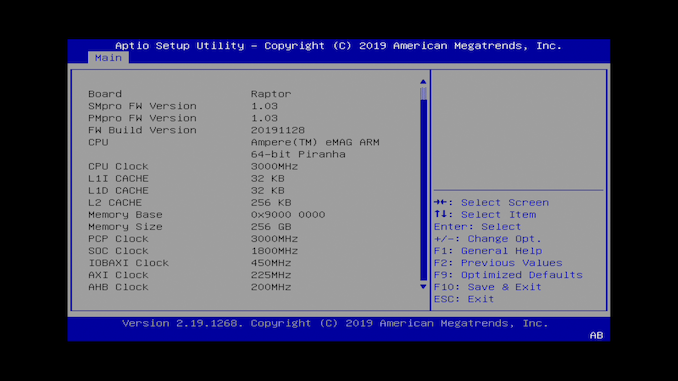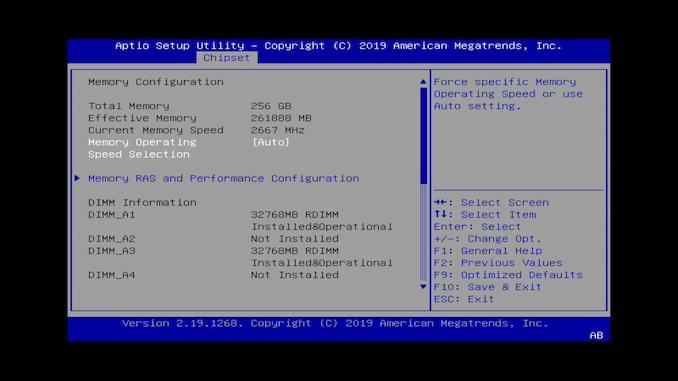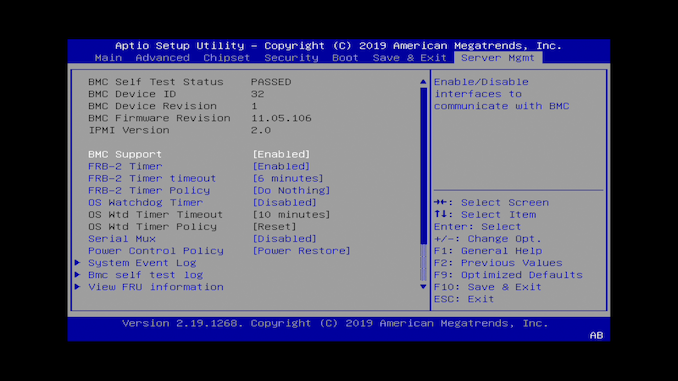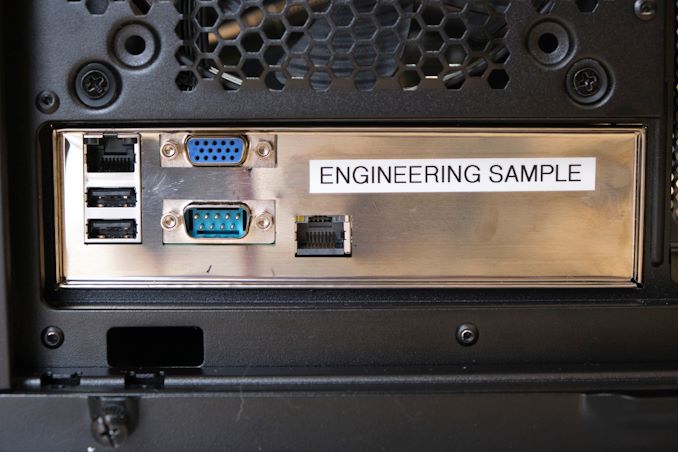Avantek's Arm Workstation: Ampere eMAG 8180 32-core Arm64 Review
by Andrei Frumusanu on May 22, 2020 8:00 AM ESTAn Arm SBSA System
As noted, the one thing that sets the eMag Workstation apart from most other Arm-based embedded systems in the market, is the fact that it’s an SBSA (Server Base System Architecture) compliant system.
What SBSA mandates as a standard, is for a vendor to design the hardware in a certain way such that the CPU, the system timers, interrupts and PCIe handling operates in such a way, that any SBSA compliant operating system image would be able to boot on it.
That’s in stark contrast with most other Arm embedded systems in the market – take Nvidia’s Jetson Arm development kits: while these system do have images for popular OSes such as Ubuntu, these are provided and maintained by Nvidia, with customised kernels and baked-in drivers. You’re reliant on the vendor to actually update the OS images, lest you actually go ahead and compile your kernels and OS yourself – if possible at all.
An SBSA system on the other hand will be able to boot generic OS images – essentially the same way it would work on any x86 desktop or server system on the market.
In essence, that’s the one main advantage of the eMAG Workstation over any other Arm embedded system, and it’s a strong advantage from a software standpoint.
The system has a comprehensive BIOS with tons of configuration options. The options here match and exceed what you’d find in a typical x86 system – overclocking options aside of course.
One important aspect of the system is that this is a server motherboard with a BMC. The BMC is an ASPEED AST2500 chip that allows independent management of the system through the dedicated BMC Ethernet port on the back of the system, allowing for two BIOS images to be set and configured.
It also serves as the 2D driver allowing for (non-accelerated) VGA display output via the D-Sub connector on the back of the system. There’s also a serial connection for terminal access.
One big disadvantage of the BMC nature of the system and the SBSA architecture, is that boot times are horrible. Booting and rebooting the system is a matter of test of patience with each cycle taking between 4 to 5 minutes, as demonstrated in the above video capture. The BMC bootup itself is around 1:20 minutes before we get to the BIOS screen, and then another painful 3 minutes for Linux to actually boot up to the login screen. The ecosystem still has a lot of work ahead to optimise this aspect of Arm systems.





















35 Comments
View All Comments
lmcd - Friday, May 22, 2020 - link
You can't just reference the RPi 3 and 4 interchangeably. RPi 4 ranges from 2x to 10x faster than the RPi 3 depending on workload. Most SBCs surpassed the RPi 3 merely by choosing an SoC without its terrible I/O constraints. A few have 2xA72. The RPi 4 has 4xA72 at a better process node -> better clockspeed for the same thermal constraints, and no FSB limitations. Its CPU performance is ahead of all but the top-end hardware development kit boards.lmcd - Friday, May 22, 2020 - link
Apparently I'm a moron that didn't see the ODROID-N2 release. That CPU is noticeably better.SarahKerrigan - Friday, May 22, 2020 - link
It would likely win by a small to moderate amount against the Pi4 on ST, and obviously by a factor of several times on MT.Altra will increase those numbers considerably, since it should be doing 2-3x the ST eMag and a much larger factor for MT due to the core count increase.
Dodozoid - Saturday, May 23, 2020 - link
Would have been interesting if AMDs planned K12 worked out. Any idea if any part of that architecture is still alive?AnarchoPrimitiv - Sunday, May 24, 2020 - link
There's a decent amount of spelling errors and wrong word errors in this article, for example:"... having an Arm system like this is the fact that it enables YOUR (I think you mean "you") native software development, without having to worry about cross-compiling code and all of the kerfuffle that that ENTRAILS (I think you mean "entails")"
There's a few of those on every page, did anyone even proof read this once before publishing?
LordConrad - Sunday, May 24, 2020 - link
"...without having to worry about cross-compiling code and all of the kerfuffle that that entrails."Wow, who did you have to disembowel to get the cross-compiling done?
abufrejoval - Sunday, May 24, 2020 - link
He quite exaggerated the effort, because it makes little difference if you compile GCC for the host architecture or a different one: Just a matter of configuration and that's it.You have to understand that pretty much every compiler has to compile itsself, because nobody wants to code it in machine binary or assembly. The code for all supported target architectures comes with the compiler source tree and you just need to pick the proper parts to use.
It's just a tad more involved than simply running cc off the shelf.
Fataliity - Sunday, May 24, 2020 - link
"You must first compile the compiler, to then compile your code"
Sounds pretty crazy. Isn't the compilers also written in c++, which are compiling c++?
My brain hurts.
GreenReaper - Sunday, May 24, 2020 - link
It involves a frequently non-trivial, multi-step process called bootstrapping:https://en.wikipedia.org/wiki/Bootstrapping_(compi...
abufrejoval - Sunday, May 24, 2020 - link
Well, recursion really grows on you after a bit of use :-)While I am pretty sure gcc is written in C++ these days, obviously the first C++ compiler still had to be written in C, because otherwise there was nothing to compile it with. Only after the C++ compiler had been compiled and was ready to run, the compiler could be refactored in C++, which I am pretty sure was done rather gradually, perhaps never fully.
These days I doubt that the GNU Fortran, Objective-C, Go or plain old C-compiler are written in anything but C++, because there would be no benefit in doing so. But of course, it could be done (I wouldn't want to write a compiler in Fortran, but I guess some of the early ones were, perhaps with lots of assembly sprinkled in).
The GNU bootstrapping was done a long time ago, perhaps with a K&R compiler and you don't typically have to go through the full process described in the article GreenReaper linked to. Pretty sure LLVM was bootstrapped in GCC and now you could do the same the other way around, if you didn't know what else to do with your day.
I hear the Rust guys want to do a full bootstrap now, but so far their compiler was probably just done in C++. Not that they really have to, probably just because "eat your own dogfood" gets on their nerves.
The process Andrei had to use is pretty much whatever the guy who put 'cc/c++' on the shelf of your Unix/Linux had to do, except that Andrei had to explicitly configure an ARM64 v8 target during the compile, while by default the Makefile or script will pick the host architecture.
Really a pretty minor effort, trivial if you are used to build Unix/Linux applications or even a kernel or distribution from source.
And if you are developing for Android, that's what's happening all the time under the hood, there: So far nobody will want to build Android on an Android device, because it's rather slow already, even on a big server with dozens of cores.